Faces: Indian Jewish Narratives of Siona Benjamin
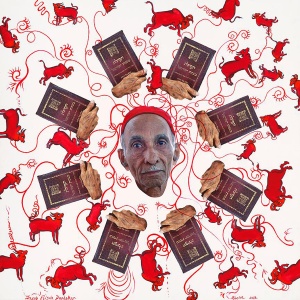
Siona Benjamin has mounted a remarkable exploration into the complex and multilayered identity of Indian Jews, simultaneously tracking the personal, communal and artistic strands that constitute the very fabric of her life. This ambitious show of over 30 large works, created within the last 2 years, was inspired by work she did on a Fulbright Fellowship in 2011 that allowed her to reconnect and explore the Bene Israel community of Indian Jews of her native Mumbai. The results confront issues of assimilation, Diaspora, piety and communal preservation that affect us all.
Benjamin presents her world as portraits, the “Faces” of its inhabitants. Daniel Elijah Benjamin is seen in profile in a golden tondo that provides a window looking into the beautifully austere Succah Shelomo synagogue in Pune India. Similarly etched on this ‘window’ is the fundamental affirmation of Jewish belief, “Shema Yisroel…” Curiously it is first seen upside down, curving around until we see the remainder of the text; “Baruch Shem Kovod…” appear right side up. This emphasizes the somewhat disorienting impression of looking into the synagogue from above and through a slightly foggy window. The impressive scale of the image, 35” x 35” accentuates the physical experience of observing the empty sanctuary alongside this pious old Jew. By its very nature a portrait in profile presents the essence of a personality; here a steadfast Jew, rich in years and experience.
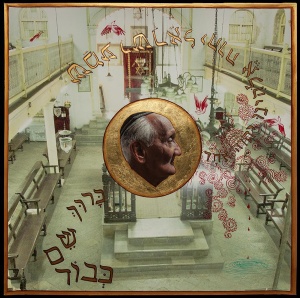
In a similar motif Jacob Elijah is presented as the epitome of a Jew fully embedded in ritual practice, here surrounded by 8 disembodied hands firmly grasping the siddur, Tifilat Kennesset Yisroel, that defined his synagogue in Alibagh. Thus crowned by the tools of his self-taught role as communal hazan; the strands of his actual livelihood, herding cows and buffalos, are seen tethered by red strings, as if one was intrinsically dependent upon the other. Not surprisingly in a predominately Hindu society where buffalos and cows are sacred, both jobs, hazan and cow herder, are equally sacred vocations.
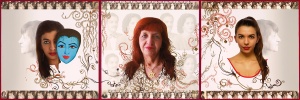
Benjamin’s attachment to her native Indian Jewish community (she left India and has been here since college) is not limited to the communal sphere; naturally it flows from the familial. Three Generations Triptych is a revealing familial self-portrait. Properly centered is the artist’s mother, Sophie Judah Benjamin, her image echoed in all three portraits. She is confident and steadfast in her faith and was a flame of inspiration to the artist. Tendrils of her hair form miniature Shabbos lamps that symbolically illuminate both her daughter and granddaughter. Arrayed along the top and bottom are old wedding photos, framed in each corner by ancestors. The immediate familial past is repeated top and bottom of both in the artist’s self-portrait and the portrait of her beautiful teenage daughter, Rachel. Again the impressive scale of the images (impossible to convey in reproduction; the entire piece is almost 9 feet long) makes the intergenerational connections physically manifest. While the artist is accompanied by her signature blue mask, a necessary transitional tool; her young daughter stands alone, simply accompanied by the shadow of her grandmother.
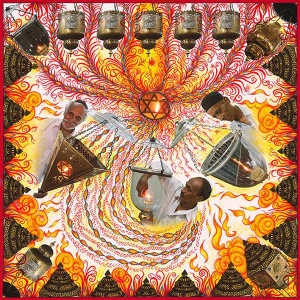
Not surprisingly the guardians of synagogue tradition is male dominated in both Moses Abraham, Cantor and Mohel and Synagogue Lamp Lighters. Moses Abraham directs with his Torah pointer a mandala of Torahs, tefillin and mohel’s scalpels. He is the stern authority of ritual observance and transmission. The Lamp Lighters on the other hand are keepers of the flame in a more elemental sense; illumination in a fully practical manner as well as the spiritual custodian of the physical synagogue. The shamash must open and close, sweep and order as well as turn the lights on and off. Jewish life could not continue without these guardians of the faith.
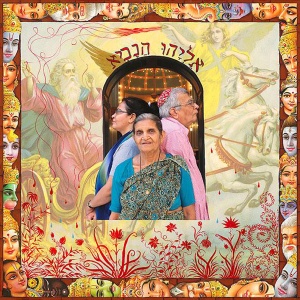
Esther Sukkur, Sukkur Enock and Queenie Sukkur, Bene Israel Family considers Indian Jewish life as a totality seen from the perspective of one family at the David Sassoon synagogue in Mumbai. This family has stayed in their community in spite of the fact that the vast majority of Indian Jews have left over the last 40 years for Israel, US and Canada. They stand as a family, back to back, unfazed by the world around them that is symbolized by a frame of smiling Hindu deities. We see them against a heroic and romantic image of Eliyahu HaNavi, mounted on a celestial chariot about to take him to his heavenly abode. White stallions leap into action under the command of a watchful angel, directing both his and, presumably, the Jewish community’s salvation. This paradigm worked for centuries of peaceful coexistence as long as there were Jews in India. In many ways Siona Benjamin’s paintings, “Faces,” ask “what now” in an increasingly spare Indian Jewish future.
Flomenhaft Gallery
547 West 27th Street, Suite 200, New York, NY
212 268 4952 [email protected]
Tuesday – Saturday, 10am – 5pm
March 6 – April 26, 2014